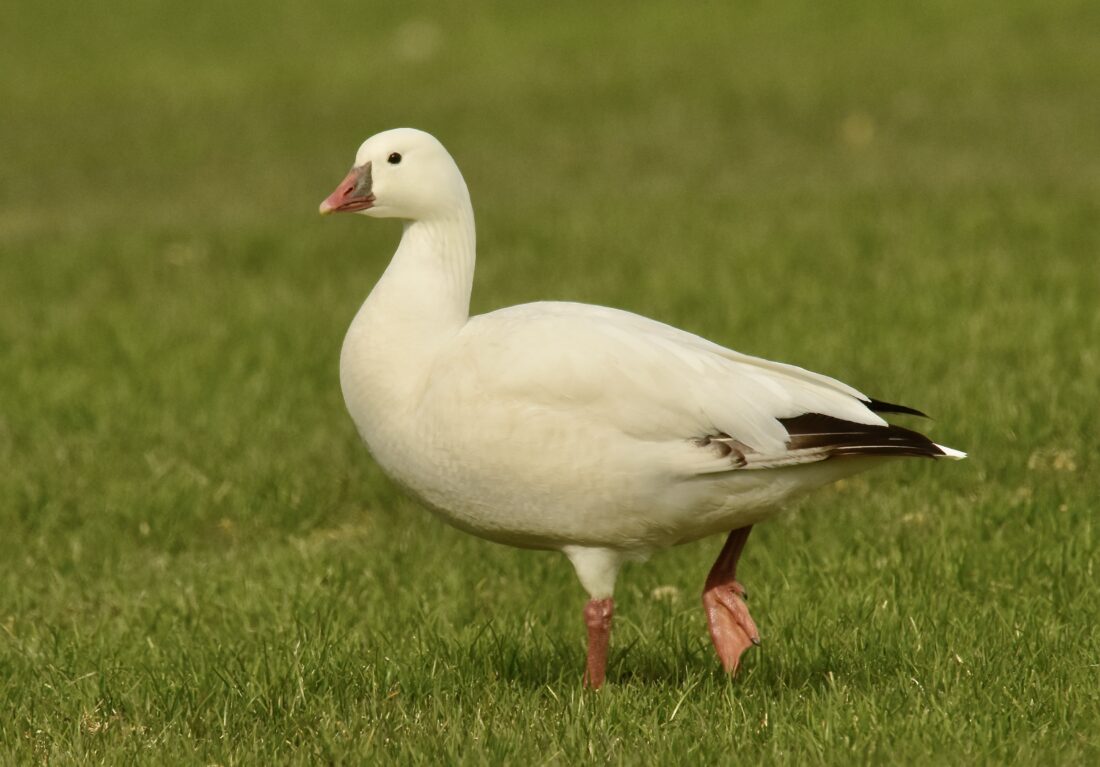Geese set good example for us

A Ross’s goose runs along. (Scot Stewart photo)
“Geese always support each other. When a goose gets injured two birds always accompany it down to the ground. Just as geese do, we must support each other.” — Emma Hayes
A goose was the spring star in Marquette this week! Migration brought a ton, yes a ton, of great birds to the Upper Peninsula this past week. It did look like the real peak of spring migration across the area as the diversity of new arrivals seemed to be rising daily.
Last week got a real star as a Ross’s goose joined the Canada geese out near the Superior Dome. This is the smallest adult goose to be seen in the Upper Peninsula. They are usually all white except for black wing tips and pink bills but a few are similar to the “blue phase” snow geese with dark gray-blue – white mix of feathers. They are similar to the larger snow geese. In addition to the smaller size, they also have a fairly straight-line connection of their bill to their cheeks. Snow geese have a curved interface.
As the Ross’s goose range has extended eastward on both summer range in the Arctic and winter range, mostly in parts of California and the southcentral U.S., they have had more contact with snow geese. The result has been an increase in hybridization between the two species. Ross’s geese do show up occasionally in the central U.P., usually singly or in pairs, and are often found with flocks of Canada geese. The group in north Marquette has mastered safety issues by feeding frequently inside a fenced-in playing field, free from worries about people, dogs, and coyotes.
Ross’s geese summer on the tundra of Canada where their numbers and populations of snow geese have grown considerably over the years. Their young are somewhat unique, sometimes starting as yellow, sometimes as gray fuzz-balls. Both eventually turn out looking the same. The increasing numbers of snow and Ros’s geese have led to some damage to the vegetation on their summer range those raising concerns.
Other surprise birds have also appeared in Marquette this past week. An adult black-crowned night-heron was found last Saturday in a maple tree along the Lake Superior shore near the U.S. Coast Guard Station in the Lower Harbor. Two days later an immature black-crowned night-heron was found in the same general area, without the adult. There are very unusual birds in this part of Marquette County.
The next day a northern mockingbird was seen back near the Superior Dome. This sleek relative of the brown thrasher and gray catbird is an official resident of the entire Lower 48, but are not seen with any regularity in the northern U.P. except during spring and sometimes fall migration. Similar in appearance to the gray catbird, they do have white wing bars to help with their ID. Their song is similar to brown thrasher’s and catbird’s but varies with the inclusion of tidbits of song phrases from other birds, making them sound like a small chorus of songbirds taking turns.
Blue jay numbers have continued to rise and fall as waves continue to pass through the area. Flocks of one or two hundred have been reported again this past week at Whitefish Point in Chippewa County. White-crowned sparrows have also lingered here in big numbers with a dozen or more at many area feeding stations.
As ducks and sparrows have moved on, insect eaters like swallows, swifts, thrushes, and wrens have continue to move in the skies of wooded areas as plovers and sandpipers have moved through along the shores. Spotted sandpipers have been seen on a number of beaches and been shadowed by more American white pelicans moving through. A small flock of pelicans was seen at Tourist Park last Tuesday.
The Lower Harbor breakwall should be a good place to watch for sandpipers and plovers as the weather continues to warm. Large hatches of midges over the past few years often leave the rocks and concrete covered with high protein meals for these shorebirds as they make epic journeys from the Gulf or even farther south all the way down to the tip of South America northward to the Alaskan and Canadian Arctic. Because the journey is so long for some these stops are crucial for the birds to refuel before taking on the last leg or two of their trip. Flocks of as many as 100 semipalmated sandpipers have been found on the breakwall on some spring days feeding.
Similar stops are made by some warblers as they head from South American rainforests and the Caribbean to the boreal forests of Canada and Alaska. They try to hit Lakes Huron and Michigan shores of the U.P. just as these midges hatch and alight in the cedars, spruces, and balsam firs along the shore. Les Cheneaux and the tip of the Stonington Peninsula are classic spots for birders to catch hundreds of warblers stopping to feed when condition are good. The next two weeks will be great times to try for these flocks along the northern shores of those Great Lakes. Mixed with these flocks, birders can look for a variety of summer residents and vagrants caught up with flock migration. Scarlet, summer and even western tanagers, Baltimore, Bullock’s and orchard orioles, blue-gray gnatcatchers, and red-headed woodpeckers are just a few of the special birds that appear along these shores in May.
These will be the last two to three weeks of big migration waves for most species. Fill those feeders and get out to make the most of it.
EDITOR’S NOTE: Scot Stewart is a teacher at Bothwell Middle School in Marquette and a freelance photographer.


